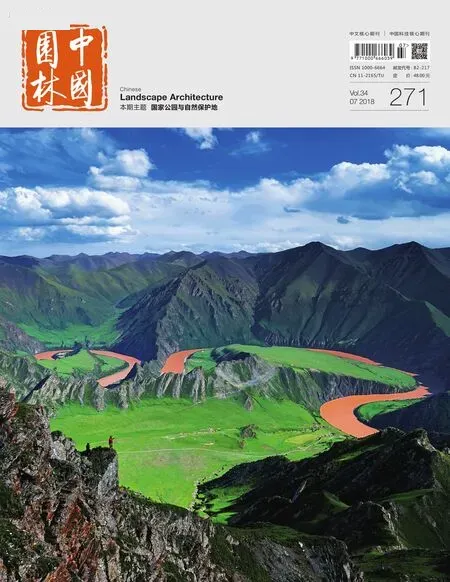刊首语
杨锐
本期主题为 “国家公园与自然保护地”。7篇主题文章涉及3个相互关联的概念:国家公园、自然保护地和风景名胜区。
“国家公园”有2个思想源头:其一是英国诗人威廉·华兹华斯于1810年提出的 “国家财产”(national property),其二是美国艺术家乔治·卡特林于1832年提出的 “国家公园”(national park)。华兹华斯 “国家财产”思想的历史背景是英国自15世纪开始并愈演愈烈的 “圈地运动”,这个运动导致英国公共荒地的大规模流失,并使其公民,尤其是当时急需改善公共卫生状况的工人阶级难以进入乡村风景。因此华兹华斯提出将英格兰的 “湖区”(Lake District)建设成为 “每个人都应享有权益的某种国家财产,供人民用眼睛来感知,用心灵来感受”。卡特林 “国家公园”概念的历史背景是美国 “西部大开发”可能对美国西部 “荒野”“印第安文明”和 “北美水牛”不可逆转的毁灭性打击,因此他呼吁政府设立国家公园,“其中有人也有野兽,所有的一切都在自然之美中处于原始和鲜活的状态”。华兹华斯强调的是公民平等的 “风景权益”,卡特林着重的是朴素的 “生物”和 “土著文化”保护。这2个思想源头分别代表了世界国家公园运动的2个基础性价值导向,即 “全民公益性”和 “生态保护”。本期主题文章《国家公园的公益性内涵及中国风景名胜区的公益性提升对策研究》讨论的是前者,其他6篇主题文章研究的对象大体是后者。
1872年美国 “黄石国家公园”建立以后,“国家公园”在数十年间迅速扩展到北美洲、大洋洲、欧洲、非洲和亚洲,目前世界上100多个国家建立了国家公园制度。《英国国家公园风景特质评价体系及其启示》和《法国国家公园管理和规划评述》介绍了欧洲2个国家在国家公园建设方面的经验。《基于文献计量分析的国家公园建设英文文献述评》定量评述了有关国家公园的英文文献。
目前“国家公园”已从单一概念发展成为“自然保护地”这一系列性概念。“自然保护地”(Protected Area)是由IUCN(国家自然保护联盟)定义的,即 “通过立法或其他有效途径识别、专用和管理的,有明确边界的地理空间,以达到长期自然保育、生态系统服务和文化价值保护的目的”的土地。“国家公园”属于IUCN 6类自然保护地中的第2类。《IUCN保护地管理分类研究与借鉴》详细介绍了这一分类体系及其对中国的借鉴意义。《论中国自然保护地的远景规模》提出了广义自然保护地的概念,即所有专用或兼用于自然保护的土地,并论述了其国土占比50%的远景目标及其可行性。
“风景名胜区”是一个极具中国特色的自然保护地类型,反映了中国数千年农业文明发展过程中自然与文化水乳交融、珠联璧合的特点。在中国 “建立以国家公园为主体的自然保护地体系”时,“风景名胜区”的价值应该被进一步研究、发掘、识别和保护,风景名胜区的“全民公益性”应得到进一步提升。在此基础上,风景名胜区这一类型不仅不应该被弱化,反而应该得到进一步的强化。《论风景名胜区整体价值及其识别》和《国家公园的公益性内涵及中国风景名胜区的公益性提升对策研究》在这一方面做了有益的探讨。
The theme of this issue is "National Park and Nature Reserve". The seven thematic articles deal with three interconnected concepts: national park, nature reserve and scenic area.
The "national park" has two sources of thoughts: one is the "national property"proposed by the English poet William Wordsworth in 1810, and the other is the "national park" proposed by the American artist George Catlin in 1832. The historical background of Wordsworth's "national property" thought was the "Enclosure Movement" that begun to intensify in Britain since the 15thcentury. This movement led to the massive loss of public wasteland in the UK and made it difficult for citizens, especially the working class in urgent need of improved public health, to enter the rural landscape. Therefore, Wordsworth proposed to build England's "Lake District" into "a kind of national property that everyone could enjoy, for the people to percept with their eyes and feel with their hearts". The historical background of Catlin's concept of the "national park" was the irreversible devastating blow to the "wilderness", "Indian civilization", and "North American buffalo" by the "western development" of the United States. He therefore called for the government to set up the national park, "with people as well as beasts, and everything is in the original and living state in the beauty of nature". Wordsworth emphasized the equal "scenery interest"of citizens, while Catlin focused on the protection of the plain "biology" and "indigenous culture". These two sources of thoughts represent the two basic values of the world’s national park movements, namely, "public welfare" and "ecological protection". The theme articleResearch on the Public Welfare of National Parks and Its Enlightenment for Scenic Areas in Chinadiscusses the former, and the other six articles generally study the latter.
After the establishment of the "Yellowstone National Park" in the United States in 1872, "national parks" rapidly expanded to the North America, Oceania, Europe, Africa and Asia in several decades. At present, more than 100 countries in the world have established the national park system.Review and Enlightenment of the British National Park Landscape Character Assessment SystemandReview on the Management and Planning of National Park System in Franceintroduce the experiences of two European countries in the construction of national parks.Critical Review of English Literature for National Parks Based on Bibliometric Analysisquantitatively reviewed the relevant English literatures on national parks.
At present, "national park" has evolved from a single concept to a serial concept of "protected area". The Protected Area is defined by the IUCN (National Union for Conservation of Nature), namely "a protected area is a clearly defined geographical space,recognized, dedicated and managed, through legal or other effective means, to achieve the long term conservation of nature with associated ecosystem services and cultural values".The "national park" belongs to Category II of the six categories of the IUCN Protected Area.Research and Reference on IUCN Protected Areas Management Categories and Their Applicationsintroduces this classification system in detail and its reference to China.Discussion on the Long-term Target of Protected Area Coverage in Chinaproposed the concept of the generalized natural protection area, that is, all lands dedicated to or concurrently used for natural protection, and discusses its long-term goal of 50% coverage of the national territory and its feasibility.
The "scenic area" is a type of nature protection area with Chinese characteristics and reflects the characteristics of natural and cultural harmony and perfection in the development of agricultural civilization in China for thousands of years. When China"establishes the system of natural protected areas with national parks as its main body", the value of "scenic area" should be further studied, excavated, identified, and protected. The"universal public welfare" property of scenic area should be further enhanced. On this basis,the type of scenic area should be further strengthened instead of weakened.On the Holistic Value of Scenic Areas and Its IdentificationandResearch on the Public Welfare of National Parks and Its Enlightenment for Scenic Areas in Chinahave done useful work in this respect.
- 中国园林的其它文章
- 国家公园的公益性内涵及中国风景名胜区的公益性提升对策研究

